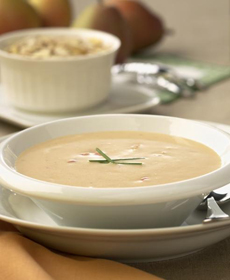
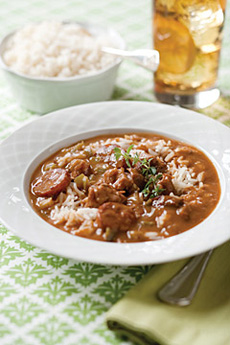
Louisiana-style gumbo with chicken, sausage and vegetables with a hint of spice that makes Cajun cuisine. Photo courtesy MackenzieLtd.com.
April 2010
Last Updated October 2013
|
 |
Types Of Soups: D To N
Page 4: Do You Know A Gumbo From A Menudo?
This is Page 4 of a six-page glossary. It features goulash, gumbo, minestrone, mulligatawny and other soups from D to N. There are thousands of soups in the world’s cuisines; this glossary focuses on those likely to be found in America, whatever their national origin. Click on the black links below to visit other pages. See all of our delicious food glossaries.
DESSERT SOUP
While fruit soups are sweet, they are not necessarily dessert soups, but can be served in the beginning or the middle of the meal. Some cultures have soups specified as desserts. Examples include etrog, a citron soup eaten during the Jewish feast of Succoth; ginataan (guinataan), a Filipino soup made from coconut milk, fruits and tapioca; and oshiruko, a Japanese soup made from the azuki bean (the same bean used to make red bean ice cream).
DRY SOUP MIX
For hundreds of years before the introduction of dry soup mixes, portable home-crafted soup mixes were carried, rehydrated and consumed by explorers, soldiers and travelers. Water was readily available when restaurants were not. Commercial dried soup mixes were introduced in the 1930s and took off in the 1940s, promoted as a convenience food to busy housewives.
EGG DROP SOUP
A Chinese soup (the literal translation is “egg flower soup”) is a Chinese soup made of beaten eggs in boiled chicken broth, which create fine strands. Pepper and finely chopped scallions are also commonly added. Stracciatella is an Italian version that includes Parmesan cheese. |
|
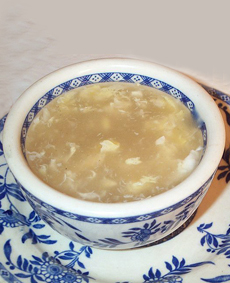
Egg drop soup. Photo by Stu Spivack | Wikimedia. |
FRENCH ONION SOUP
Onion soups date back at least to Roman times. Throughout history, they were sustenance for the poor, as onions were plentiful and inexpensive. Onions were also thought to have restorative powers, making them a perfect choice for a nourishing soup. There are numerous styles of onion soup and related leek soup. French onion soup became popular in the U.S. with the post-World War II growth of French cooking. The recipe, made from beef broth and caramelized onions and served in an individual crock or ramekin, topped with croutons and finished with Gruyère under a broiler (Soupe a l’Oignon Gratinée), developed in 18th-century France, a descendant of modern French bouillon that emerged in the 17th century, which in turn harkens back to the Medieval sops, a piece of bread over which a soup was poured.
|
|
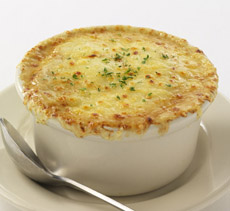
French Onion Soup is known for its thick crust of broiled Gruyère cheese. Photo courtesy Morton’s The Steakhouse. |
FRUIT SOUP
A soup made from fresh or dried fruit. Fruit soup can be served hot or cold, depending on the recipe. Cold soups tend to be made with seasonal fruit and are thus served in warmer weather. Soups made of dried fruits, such as Norwegian fruktsuppe (made of raisins and prunes), can be served hot or cold in any season. Fruit soups can be cream soups or purées with or without the addition of fruit juice, and can include alcohol such as brandy, champagne, Port or wine. Sweet fruit soups can include meat; and in at least one instance, a fruit soup can be completely savory, like the Chinese winter melon soup. While fruit soup can be served for dessert, it also can be a first course or an intermezzo between fish and meat courses.
|
|
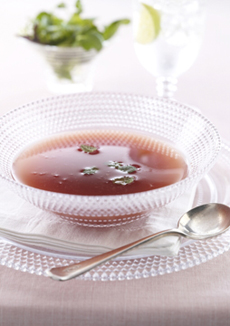
Fruit soup. Photo courtesy Watermelon.org.
|
GAZPACHO
A specialty of Spain and Portugal, gazpacho is a cold raw vegetable soup originating in Andalusia, the southernmost region of Spain. The name is of Arabic origin, and literally means “soaked bread”; the original recipe came from the Arabs who occupied much of Spain from the 8th through the 13th centuries. The term has become generic for “cold vegetable soup.” Early on, it was a way for field workers to make lunch from the vegetables at hand, and stale bread was added to the recipes. An Andalusian recipe typically includes stale bread, bell pepper, garlic, olive oil, onion, tomato, wine vinegar and salt. Since the tomato—a new world fruit that was brought to Europe by the Spanish conquistadors—was not eaten until the 1800s,* it is a newer addition to the recipe.
|
|

Gazpacho—served here from a punch bowl at a picnic, with ice! Photo courtesy UmamiInfo.org. |
There are many variations of gazpacho, depending on local preferences. American recipes tend to leave out the bread, although some may garnish the soup with a garlic crouton. White gazpacho is made with olive oil, sherry vinegar, bread, garlic and salt, and substitutes green grapes and almonds for the vegetables.
*A member of the Nightshade family of plants, the tomato was deemed poisonous until it was eaten out of desperation during a famine in the early 1800s in Italy. The original tomato was the cherry tomato, which made an attractive house plant.
|
GOULASH SOUP
From Hungary, a soup/stew, made with beef, pork, bell peppers, onions, potatoes and tomatoes and seasoned with paprika, caraway seed, marjoram and thyme. It can be served over noodles or with dumplings, but either way, be sure to garnish with sour cream! Goulash (gulyas) dates back to 9th century Hungarian shepherds' “gulyas" literally translates as "herdsmen." Soup played a key role in the early pastoral diet. Dried meats and vegetables were eminently portable and easily reconstituted. Over the years, Hungarian Goulash evolved from peasant fare to signature national dish.
|
|
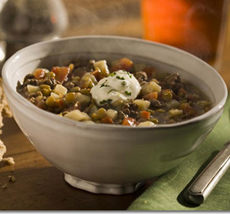 Goulash. Photo courtesy FrontierSoups.com. Goulash. Photo courtesy FrontierSoups.com. |
GUMBO
A Creole soup from Louisiana, thickened with okra pods. “Gumbo” is an African word for okra. Okra came to America with the slave trade and was introduced to the white population by African cooks. As with all recipes, there are regional variations and different styles of gumbo. Here’s a recipe for gumbo from chef Emeril Lagasse. |
|
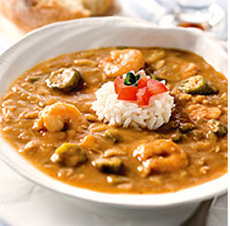 Seafood Gumbo. Photo courtesy Seafood Gumbo. Photo courtesy
MackenzieLtd.com. |
HOT AND SOUR SOUP
Hot and sour soup refers to a number of different Asian soups—from Cambodia, China, Thailand and Vietnam—that contain ingredients that give the soup both hot (spicy) and sour flavors. The most familiar in the U.S., from the Chinese Szechuan cuisine, is typically made hot (spicy) with red chiles or white pepper, and sour with vinegar. Other ingredients can include bamboo shoots, day lily buds, egg, a variety of mushrooms (button, cloud ear and wood ear), sesame oil, soy sauce, strips of pork and tofu. The soup is thickened with cornstarch or tapioca. |
|
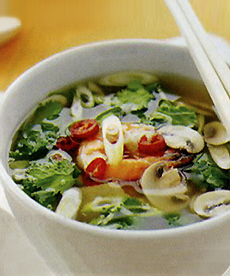
Hot and sour soup. Photo courtesy
Turner Publishing. |
ITALIAN WEDDING SOUP
An Italian-American soup of green vegetables (endive and escarole or cabbage, lettuce, kale, and spinach) with meatballs and/or sausage, in a clear chicken broth. The soup sometimes contains pasta as well. It originated in Western Pennsylvania or Ohio, and is not a wedding specialty but it is found on restaurant menus. “Wedding soup” is a mistranslation of minestra maritata, “married soup,” which refers to the “marriage” of the green vegetables to the meat. An earlier, heavier form of minestra maritata, with much more meat, was popular in Toledo, Spain. |
|
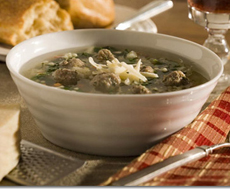
Italian Wedding Soup. Photo courtesy
FrontierSoups.com. |
LEEK SOUP
A more elegant version of onion soup, made with softer-flavored leeks and often including potatoes.
LENTIL SOUP
One of the first crops domesticated in the Near East, the high-protein lentil (also an excellent source of fiber, iron and potassium) has been part of man’s diet since Neolithic times. Lentil soup is mentioned in the Bible and in the plays of Aristophanes. It can be vegetarian or meat-based, thick or broth-like. It is generally combined with other vegetables—carrots, celery, onion and potatoes—and seasoned with parsley and other herbs.
MANHATTAN CLAM CHOWDER
Clam chowder with a tomato base. See chowder.
|
|
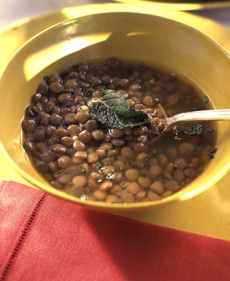
Lentil soup. Photo courtesy Zursun. |
MARYLAND CRAB SOUP
A specialty of Maryland, whose Chesapeake Bay was once full of blue crab (alas, now much depleted through overfishing and pollution). The soup is a spicy chicken stock and tomato base chock full of vegetables. It includes blue crab, vegetables, blue crab, Old Bay Seasoning, Worcestershire sauce, olive oil, lemon pepper, garlic, onion, celery, potatoes, lima beans, green beans and corn.
MENUDO
A traditional Mexican soup made of hominy, tripe, calf’s feet and seasonings including cilantro, lime, onions, red chiles and oregano. It can be a clear broth or have a red chile base (menudo colorado). Menudo is usually eaten with tortillas. |
|
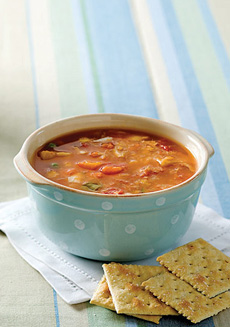
Maryland Crab Soup. Photo courtesy CB Crabcakes. |
MINESTRONE SOUP
Meaning “big soup” in Italian, minestrone is a thick Italian vegetable soups that includes Roman beans and often pasta or rice. It uses seasonal vegetables and can be vegetarian, contain meat and/or use a meat-based stock.
MISO SOUP
Miso soup, a Japanese staple, is made from a kelp- and bonito-based stock called dashi, into which is miso paste is mixed. Although the suspension of miso paste into dashi is the only characteristic that actually defines miso soup, many other ingredients are added depending on regional and seasonal recipes, and personal preference. |
|
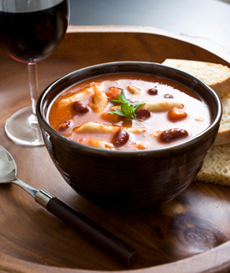
Minestrone soup. Photo by Joe Blafore| ISP. |
MULLIGATAWNY SOUP
A thick, curried Anglo-Indian soup of meat (chicken or lamb), vegetables and spices, typically garnished with parsley. The name means “pepper water” in the Tamil language (millagu is pepper, thanni is water); although pepper is not a component, and the dish called “pepper water” by Anglo-Indians is more like tamil rasam soup. There are many variations on the mulligatawny recipe. Often it is thickened with rice, and the addition of of turmeric can turn the soup a pronounced yellow color.
NEW ENGLAND CLAM CHOWDER
Clam chowder with a cream base and potatoes. See chowder.
|
|
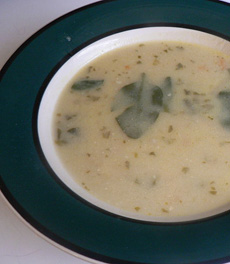
Mulligatawny soup. Photo by Stu Spivack | Wikimedia. |
NOODLE SOUP
Many cultures have noodle soups. Chicken noodle soup is one of the most popular soups in the U.S. Fun, the Chinese word for noodles, appear in many widths from angel hair to broad noodles in variously flavored broths (as well as non-broth noodle dishes). Pho, a spicy Vietnamese noodle soup, is one of that cuisine’s memorable dishes. Many a college student has subsisted on Japanese ramen. And Italy, has Pasta Fagioli, pasta and bean soup. As you can see in the photo at right, the pasta isn’t limited to short egg noodles or long pasta, but can be any cut. Some noodle history:
|
|
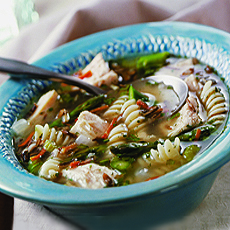
Chicken, wild rice and corkscrew pasta soup. Photo courtesy FrontierSoups.com. |
The Chinese invented noodles; the Arabs brought them to the Middle East over the Silk Road, and then to Sicily from where they traveled north through the Italian peninsula. The Italians took the noodle to new creative heights, with the gratitude of pasta lovers everywhere.
Continue To Next Page: Soups O To Z
Go To The Article Index Above
Lifestyle Direct, Inc. All rights reserved. Images are the copyright of their individual owners.

|






